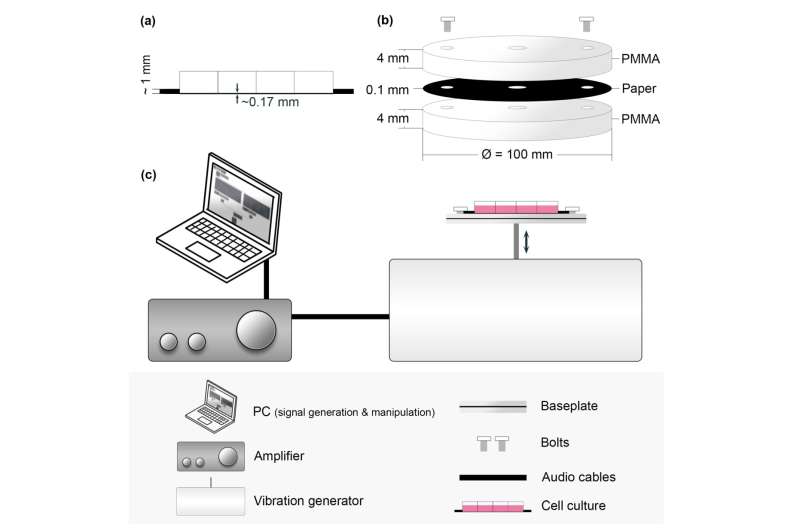This article has been reviewed according to Science X's editorial process and policies. Editors have highlighted the following attributes while ensuring the content's credibility:
fact-checked
trusted source
proofread
Research investigates music's effects on cells with implications for diabetes treatment

Could music affect cells? According to a recent life science project, it is possible. The results may be a first step to using music to treat diabetes.
If you have diabetes, the cells in the pancreas are unable to produce insulin, which is needed by the body to regulate blood sugar. Currently, efforts are being made in labs worldwide to create insulin-producing cells from human induced Pluripotent Stem Cells (hiPSCs) that can replace insulin supplements.
One of these research environments was the ABINO project, where biologists, physicists and music technology researchers have worked together to enter the field from a new angle: influencing cells through music.
Researcher Dongho Kwak practically had to start from scratch when he began his Ph.D. as part of the project. He had a background in audio technology and, as an orchestral flutist; he knew that sound can affect the body to some extent. However, aiming to investigate the cellular level, he did not have much other research to look at.
There had been some former attempts to stimulate cells with sound, but there was a lack of systematic research.
Rhythms are essential in biology
"I was curious as to whether I could shape a sound relevant to living cells. The fact that cells can sense sound at all was not obvious," Kwak says, a research fellow at the RITMO Center for Interdisciplinary Studies in Rhythm, Time and Motion at the University of Oslo.
He had to work systematically, he explains.
"Basically, you can take any piece of music and play it for the cells in the lab. However, the analysis will get a bit difficult. Music has complex structures; it has many different elements, such as melody, harmony, and rhythm. It can be difficult to say precisely what affects the cells."
While thinking about what a key element could be, research in physiological systems grabbed Kwak's attention. In "Rhythms in Physiological Systems" from 1991, he found an interesting statement in the introduction: "Rhythms are a basic phenomenon in all physiological systems."
"The authors illustrated that rhythm has a fundamental function in critical parts of the physiology, such as cardiovascular, respiratory, and motor systems. For music, it is the same, because, what is music without rhythm?"
Sound affected the cells
Kwak divided the cells into four groups: One group was exposed to a steady rhythm for fifteen minutes, the second to an irregular rhythm, the third to a continuous sound, and the fourth was a control group with no sound.
Afterwards, he studied the cells' filaments. These are skeleton-like structures in the cells partly made of thin, long threads, and they are sensitive to external influences.
"In our published work, we have preliminarily concluded that the filament structures have shrunk after being exposed to sound. They had become shorter. The effect was strongest for the cells that had been exposed to a continuous sound. Perhaps the continuous sound was causing the most stress."
The results are published in the journal Bioengineering. Kwak describes them as a milestone, but prefers the word "preliminary" due to the uncertainty of the findings. More research is required to establish a secure link between rhythm and cell behavior, he explains.
The study may open new ways to experiment with cells
The changes we observed in the sound-exposed cells do not imply that music is good or bad for cells, Kwak emphasizes.
"It only suggests that cells respond to rhythmic sounds in an interesting way, which gives researchers something to work on. It could be that cells would respond to different pitches and varying intensities as well, but we do not know that yet."
Professor Alexander Refsum Jensenius is the head of the RITMO center and one of the initiators of the research project Kwak has been working on.
"The fact that rhythmic sound seems to affect the cells is incredibly interesting. Usually, cell researchers need plenty of chemicals to stimulate cells. If it is possible to stimulate cells using vibration, such as sound, it could lead to new ways of experimenting with cells," Jensenius says.
A need for robust protocols
The idea behind the ABINO project came across when Jensenius was sitting next to cell researcher Hanne Scholz at a dinner. Scholz had heard lab people talk about music in the lab seemingly affecting cells. Scholz, a researcher at the Faculty of Medicine, University of Oslo, was the project leader of ABINO.
The team hopes that the project will inspire further research in this direction to understand how cells would respond to rhythms.
Creating insulin-producing cells, which could be transferrable to humans as stem cells, is still a long shot, according to Jensenius.
"However, if we are to get there, we need robust protocols, meaning methods. Finding new ways of cultivating cells in the lab is definitely of interest," Alexander Refsum Jensenius says.
More information: Dongho Kwak et al, Characterization of Mechanical and Cellular Effects of Rhythmic Vertical Vibrations on Adherent Cell Cultures, Bioengineering (2023). DOI: 10.3390/bioengineering10070811




















